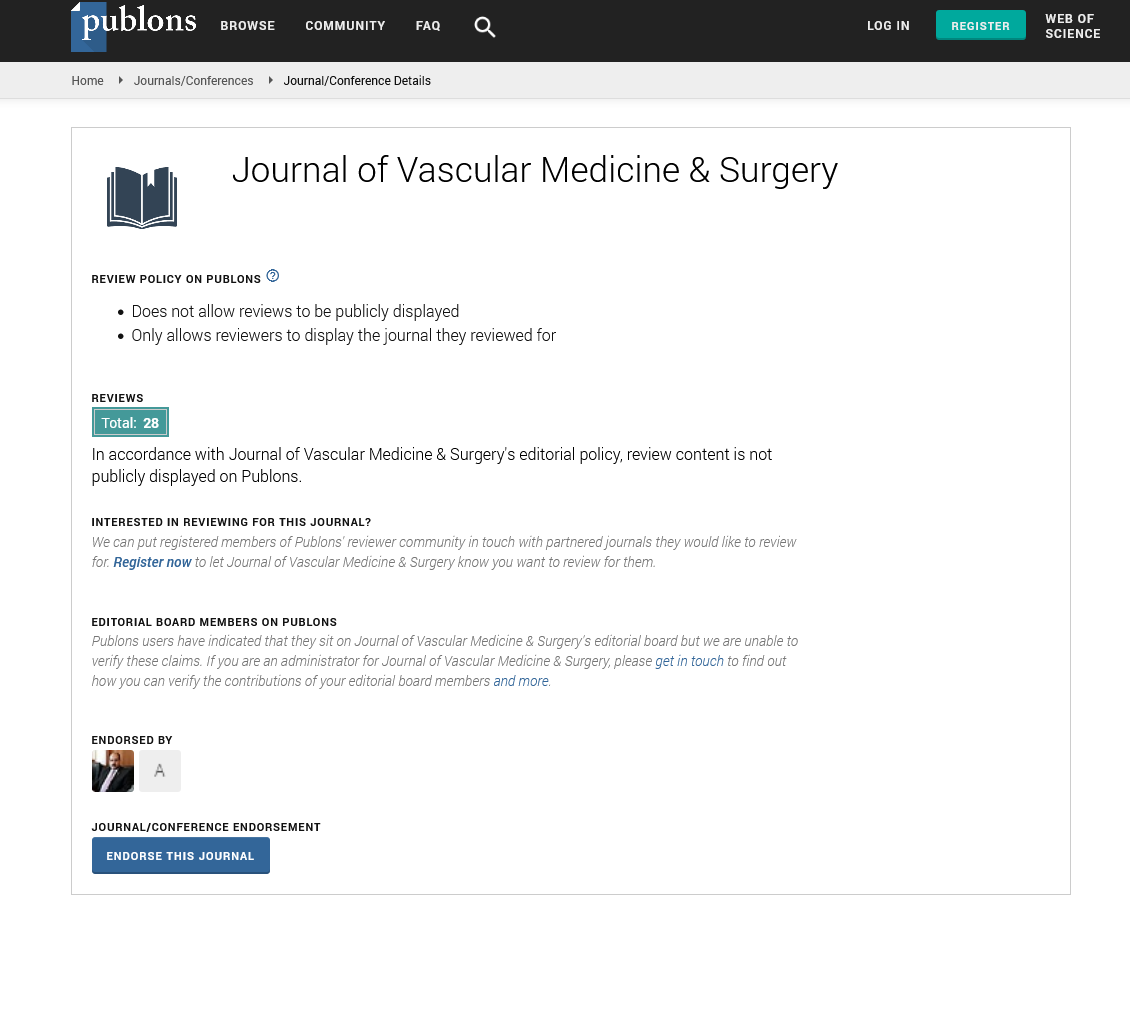Indexed In
- Open J Gate
- Academic Keys
- RefSeek
- Hamdard University
- EBSCO A-Z
- OCLC- WorldCat
- Publons
- Euro Pub
- Google Scholar
- SHERPA ROMEO
Useful Links
Share This Page
Journal Flyer

Open Access Journals
- Agri and Aquaculture
- Biochemistry
- Bioinformatics & Systems Biology
- Business & Management
- Chemistry
- Clinical Sciences
- Engineering
- Food & Nutrition
- General Science
- Genetics & Molecular Biology
- Immunology & Microbiology
- Medical Sciences
- Neuroscience & Psychology
- Nursing & Health Care
- Pharmaceutical Sciences
Commentary - (2025) Volume 13, Issue 3
The Evolution of Endovascular Approaches in Peripheral Arterial Disease
Munoz Rivas*Received: 28-Feb-2025, Manuscript No. JVMS-25-28761; Editor assigned: 03-Mar-2025, Pre QC No. JVMS-25-28761 (PQ); Reviewed: 17-Mar-2025, QC No. JVMS-25-28761; Revised: 24-Mar-2025, Manuscript No. JVMS-25-28761 (R); Published: 31-Mar-2025, DOI: 10.35248/2329-6925.25.13.588
Description
Over the past two decades, the treatment landscape for Peripheral Arterial Disease (PAD) has undergone a remarkable transformation. With the prevalence of PAD continuing to increase globally—affecting an estimated 200 million individuals worldwide—the search for optimal therapeutic strategies remains a priority for vascular specialists. This commentary examines the current state of endovascular interventions in PAD management and explores emerging technologies that may shape future practice.
The endovascular revolution in PAD treatment began with simple balloon angioplasty, which has since evolved to include a diverse armamentarium of techniques: Drug-Coated Balloons (DCBs), Drug-Eluting Stents (DES), atherectomy devices, and specialized crossing tools for chronic total occlusions. This evolution reflects our growing understanding of the complex pathophysiology of PAD and the limitations of earlier approaches.
Recent randomized controlled trials have demonstrated the superiority of drug-coated technologies over plain balloon angioplasty in terms of patency rates and freedom from target lesion revascularization (TLR). The LEVANT 2 and IN.PACT SFA trials established DCBs as effective in femoropopliteal lesions, showing significant reductions in late lumen loss and reintervention rates. Similarly, the Zilver PTX and IMPERIAL trials validated the benefits of DES in the superficial femoral artery, with improved primary patency rates at 12 months compared to bare metal stents.
However, the landscape grew more complex in 2018 when a meta-analysis by Katsanos et al. raised concerns about increased long-term mortality associated with paclitaxel-coated devices. This precipitated intense scrutiny from regulatory bodies and a temporary decline in their utilization. Subsequent analyses, including the SAFE-PAD study examining over 160,000 Medicare beneficiaries, found no significant difference in mortality between patients treated with paclitaxel-coated devices versus uncoated alternatives at five years. Nevertheless, this controversy highlighted the need for more rigorous long-term safety monitoring in device development.
The debate surrounding "leave nothing behind" strategies versus permanent implants continues to evolve. Proponents of scaffold-free approaches argue that avoiding foreign material preserves future treatment options and eliminates concerns about in-stent restenosis or fracture. Conversely, stent advocates point to superior acute procedural success and the mechanical advantages of scaffolding in heavily calcified or eccentric lesions. The emergence of Bioresorbable Vascular Scaffolds (BVS) attempted to bridge this divide, though early iterations faced challenges with strut thickness and mechanical properties. Newer generation bioresorbable technologies show promise in early trials but require further validation.
Calcified lesions remain particularly challenging in endovascular therapy. Traditional balloon angioplasty often yields suboptimal results due to elastic recoil and flow-limiting dissections. Recent innovations in calcium modification—including orbital, rotational, and laser atherectomy systems—have improved our ability to prepare vessels for subsequent interventions. The DEFINITIVE LE study demonstrated the safety and efficacy of directional atherectomy in heavily calcified lesions, while the TRUTH study showed improved acute procedural success with orbital atherectomy. Intravascular lithotripsy represents the newest addition to this space, using pulsatile mechanical energy to fracture calcium while minimizing vessel trauma.
Another significant advancement is the integration of sophisticated imaging modalities into procedural planning and execution. Intravascular Ultrasound (IVUS) and Optical Coherence Tomography (OCT) provide detailed assessment of plaque morphology and vessel dimensions, guiding device selection and deployment. The iDissection study demonstrated that IVUS-guided interventions resulted in fewer flow-limiting dissections and reduced bailout stenting. Meanwhile, co-registration of multiple imaging modalities is enhancing our understanding of plaque composition and biomechanical properties, potentially enabling more personalized treatment approaches. Specialized devices for below-the-knee interventions—historically an area with limited options—are showing promising results in early studies. Drug-coated balloons specifically designed for infrapopliteal arteries, such as those evaluated in the SAMBA and SAVAL trials, may address the high restenosis rates in this challenging vascular bed.
As endovascular technologies continue to advance, we must maintain our commitment to rigorous clinical evaluation and comparative effectiveness research. The importance of functional outcomes and quality of life measures cannot be overstated, as technical success does not always translate to meaningful clinical improvement. Future studies should emphasize patient-centered endpoints alongside traditional measures of patency and limb salvage. In conclusion, the endovascular management of PAD has progressed significantly but remains an evolving field with substantial challenges. The integration of novel devices, advanced imaging, systemic therapies, and computational approaches offers the potential for more effective and durable revascularization strategies. By embracing innovation while maintaining scientific rigor, we can continue to improve outcomes for the growing population of patients with this challenging disease.
Citation: Rivas M (2025). The Evolution of Endovascular Approaches in Peripheral Arterial Disease. J Vasc Surg. 13:588.
Copyright: © 2025 Rivas M. This is an open access article distributed under the terms of the Creative Commons Attribution License, which permits unrestricted use, distribution, and reproduction in any medium, provided the original author and source are credited.

